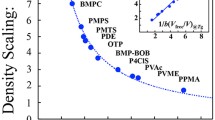Conclusion
Except the discrepancies mentioned with respect to pressure investigations, which need clarification in the future, we can conclude in a general way, as follows.
As far as only average parameters of macroscopic samples are considered (complex moduli, or dielectric constants, volume or heat content etc....), the free volume concept can relate the variations of molecular mobility to the changes of an average free volume in a semiquantitative way. This average free volume can no longer fully caracterize the wide variety of molecular motions involved in the kinetics of redistribution of holes in the liquid during the recovery experiments. These kinetic processes involve a wide distribution of retardation times, which may be associated with the local distribution of holes, or with that of cooperating groups of molecules, or molecular segments.
On the other hand, free volume is not necessarily the fundamental molecular parameter which controls the rate of configurational changes, characterized by the variation of entropy of the liquid (14). Even if this is the case, most of the above discussion may be applied to any other average excess parameter, as far as theDoolittle equation is formally adopted, in which (f/b) is expressed in terms of the new parameter, rather than that of free volume. However, since the relaxational free volume, as determined from the W.L.F. equation, and the independently measured volume changes are often in close agreement, this means that the variations of the excess entropy (12), or those of the configurational free energy (13), and the changes in volume are closely related. Therefore, the free volume concept remains still a valuable tool for unifying different kinds of rate processes from both a theoretical and an experimental point of view, especially in the glass transition range.
Similar content being viewed by others
References
Simon, F., Erg. Exakt. Naturwiss.9, 222 (1930).
Kauzmann, W., Chem. Rev.43, 219 (1948).
Kovacs, A. J., Fortschr. Hochpolym. Forsch.3, 394 (1964).
Partington, J. R., “An advanced treatise on physical chemistry” (London 1955).
Ewell, R. E. andH. Eyring, J. Chem. Phys.,5, 726 (1937).
Williams, M. L., R. F. Landel andJ. D. Ferry, J. Amer. Chem. Soc,77, 4701 (1955).
Vogel, H., Physik. Z.,22, 645 (1921).
Tammann, G. andG. Hesse, Z. Anorg. Allgem. Chem.,156, 245 (1926).
Frenkel, J., “Kinetic theory of liquids” (London 1946).
Doolittle, A. K., J. Appl Phys.,22, 1471 (1951).
Goldstein, M., J. Chem. Phys.,39, 3369 (1963).
Bestul, A. B. andS. S. Chang, J. Chem. Phys.,40, 3731 (1964).
Adam, G. andJ. H. Gibbs, J. Chem. Phys.,43, 139 (1965).
Gibbs, J. H. andE. A. Dimarzio, J. Chem. Phys.,28, 373 (1958).
Ferry, J.D., “Viscoelastic Properties of Polymers” (New York 1961).
Fox, T. G., S. Gratch andS. Loshaek, “Viscosity relationships for polymers in bulk and concentrated solutions” p. 431 in “Rheology” Ed.F. R. Eirich (New York 1956).
Plazek, D. J., J. Phys. Chem.,69, 3480 (1965).
Ferry, J. D. andR. S. Stratton, Kolloid. Z.,171, 107 (1960).
Marvin, R. S. andJ. E. McKinney, “Volume Relaxation in Amorphous Polymers” in “Physical Acoustics” Vol. II, Part B, Ed.W. P. Mason (NewYork 1965).
O'Reilly, J. M., J. Polym. Sc.,57, 429 (1962).
Koppelmann, J., Proc. 4th Int. Congress on Rheology, Ed.E. H. Lee, Part 3, p. 361 (New York 1965).
Williams, G., Trans. Faraday Soc.,60, 1556 (1964).
Passaglia, E. andG. M. Martin, J. Res. Nat. Bur. Stand.,68A, 273 (1964).
Breuer, A. andG. Rehage, Preprint N∘ 278. IUPAC Symposium on Macromolecular Chemistry, Prague, Sept. 1965 (to be published in the J. Polymer Sci.).
Prod'home, M., Verres et Refractaires,14, 261 (1960).
Zijlstra, A. L., Phys. Chem. Glasses,4, 129 (1963).
De Bast, J. andP. Gilard, Phys. Chem. Glasses,4, 117 (1964).
Kovacs, A. J., R. S. Stratton andJ. D. Ferry, J. Phys. Chem.,67, 152 (1963).
Meyer, H. H., M. F. Mangin andJ. D. Ferry, J. Polymer. Sci.,3A, 1785 (1965).
Meyer, H. H. andJ. D. Ferry, Trans. Soc. Rheol.,9, Part 2, 343 (1965).
Kawaguchi, T. andK. Fujisawa, Private comm. (to be published).
Kästner, Preprint N∘ 542, IUPAC Symposium on Macromolecular Chemistry, Prague, Sept. 1965.
Kovacs, A. J., Trans. Soc Rheology,5, 285 (1961).
Goldbach, G. andG. Rehage, Preprint N∘ 269, IUPAC Symposium on Macromol. Chem., Prague, Sept. 1965 (see also this symposium, p. 302).
Kästner, S., Kolloid Z. u. Z. Polymere,196, 143 (1965).
Sharonov, Yu. A. andM. V. Volkenstein, Vysokomol. Soed.,4, 917 (1962).
Adam, G., Kolloid. Z. u. Z. Polymere,195, 1 (1964).
Kovacs, A. J., “Phenomènes de Relaxation et de Fluage en Rhéologie non-linéaire”, p. 191 Ed. CNRS (Paris 1961).
Parks, G., L. E. Barton, M. G. Spaght andJ. W. Richardson, Physics5, 193 (1934).
Davidson, D. andR. Cole, J. Chem. Phys.,19, 1484 (1951).
McDuffie, G. E. andT. A. Litovitz, J. Chem. Phys.,37, 1699 (1962).
Bestul, A. B. Glasstech. Ber.32 K, VI/59 (1959).
Williams, M. L. andJ. D. Ferry, J. Colloid Sci.9, 479 (1954).
Author information
Authors and Affiliations
Rights and permissions
About this article
Cite this article
Kovacs, A.J. Applicability of the free volume concept on relaxation phenomena in the glass transition range. Rheol Acta 5, 262–269 (1966). https://doi.org/10.1007/BF02009732
Received:
Issue Date:
DOI: https://doi.org/10.1007/BF02009732




